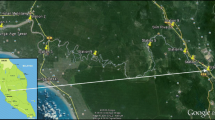Abstract
The competitive adsorption and the release of selected heavy metals and their speciation distribution before and after adsorption in the Yellow River sediments are discussed. The adsorption of metals onto sediments increases with increasing pH value and decreases with increasing ionic strength. The competitive coefficient K c and the distribution coefficient K d are obtained to analyze the competitive abilities of selected heavy metals, which are ranked as Pb > Cu >> Zn > Cd. The competition among selected heavy metals becomes more impetuous with increasing ion concentration in water. Speciation analysis was done by an improved analytical procedure involving five steps of sequential extraction. Cu, Pb and Zn were mainly transformed into the carbonate-bound form (50.8–87.7%) in adsorption. Most of (60.7–77.3%) Cd was transformed into the exchangeable form, and the percentage of carbonate-bound Cd was 19.7–30.4%. The release reaction was so quick that the release capacity of selected heavy metals from sediments to aqueous solution reached half of the maximum value only in 30 s. As opposed to adsorption, the release capacities of selected heavy metals were ranked as Cd > Zn >> Cu > Pb. In this study, Cd produces the most severe environmental hazards, because its concentration in the release solution is 85.8 times more than the human health criteria of US EPA.











Similar content being viewed by others
References
Alberty RA (1987) Physical Chemistry. 7th edn. Wiley, New York
Chen JS, Hong S, Wang LX, Wang FY (2000a) Geo-chemical parameters of river particulate in Eastern China. Acta geographica sin 55(4):417–427
Chen JS, Li HB, Xia XH, Zhai XH (2000b) A study on water-quality trend in the Yellow River system from 1960’s to 1990’s. Environ Chem 19(2):97–101
Christian Gischler (2005) Pathways of heavy metals and implication for stakeholders, Sonso Lagoon, Colombia. TRITA-LWR Master Thesis LWR -EX-05–13. Stockholm-Sweden
Du Q, Wen XH, Li LL, Tang HX (1996) Adsorption behaviours of the natural sediment on heavy metals. Environ Chem 15(3):199–206
Filius Angelika, Streck Thilo, Richter Jorg (1998) Cadmium sorption and release in limed topsoils as influenced by pH: isotherms and simulated leaching. J Environ Qual 27:12–18
Galvez-cloutier R, Jean-sėbastien D (1998) An evaluation of fresh water sediments contamination: the Lachine canal sediments case, Montrėal, Canada. Part II: heavy metal particulate speciation study. Water Air Soil Pollut 102:281–301
Gomes PC, Fontes MPF, Da Silva AG, Mendonça de ES, Netto AR (2001) Selectivity sequence and competitive adsorption of heavy metals by Brazilian soils. Soil Sci Soc Am J 65:1115–1121
Hsu PH (1989) Aluminum oxides and oxyhydroxides. In: Dixon JB, Weed SB (eds) Minerals in soil environments. ASA and SSSA, Madison, pp 331–378
Huang SL, Wan ZH, Wang LX (1995) Study on the effects of concentrations of heavy metals in sediment and initially in water phase on their adsorption. Acta Scientiae Circumstantiae 15(1):66–75
Nicole ML, Robert PM, Jean-Michel L (2001) The fate and transport of mercury, methylmercury, and other trace metals in chesapeake bay tributaries. Wat Res 35:501–515
Petersen W, Willer E, Willamowski C (1997) Remobilization of trace elements from polluted anoxic sediments after resuspension in oxic water. Water Air Soil Pollut 99:515–522
Ricou P, Hèquet V, Lecuyer I, Le Cloirec P (1999) Influence of operating conditions on heavy metal cation removal by fly ash in aqueous solutions. In: International ash utilization symposium. University of Kentucky
Schwertmann U, Taylor RM (1989) Iron oxides. In: Dixon JB, Weed SB (ed) Minerals in soil environments. ASA and SSSA, Madison, pp 379–438
Tisser A, Campdell PGC, Bisson M (1979) Sequential extraction procedure for the speciation of particulate trace metals. Anal Chem 51:844–851
US EPA (1976) Quality criteria for water (Red Book)
US EPA (1986) Quality criteria for water (Gold Book). EPA 440/5-86-001
US EPA (1999) Understanding variation in partition coefficient, Kd, values. EPA 402-R-99-004A-B, August
Acknowledgments
This work was supported by the Natural Science Foundation of China (No. 40363001).
Author information
Authors and Affiliations
Corresponding author
Rights and permissions
About this article
Cite this article
Fan, Q., He, J., Xue, H. et al. Competitive adsorption, release and speciation of heavy metals in the Yellow River sediments, China. Environ Geol 53, 239–251 (2007). https://doi.org/10.1007/s00254-007-0638-5
Received:
Accepted:
Published:
Issue Date:
DOI: https://doi.org/10.1007/s00254-007-0638-5




